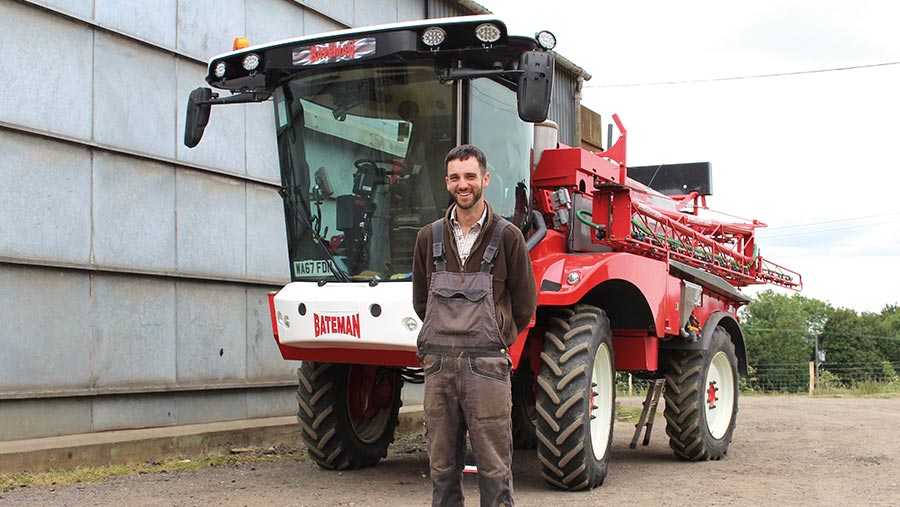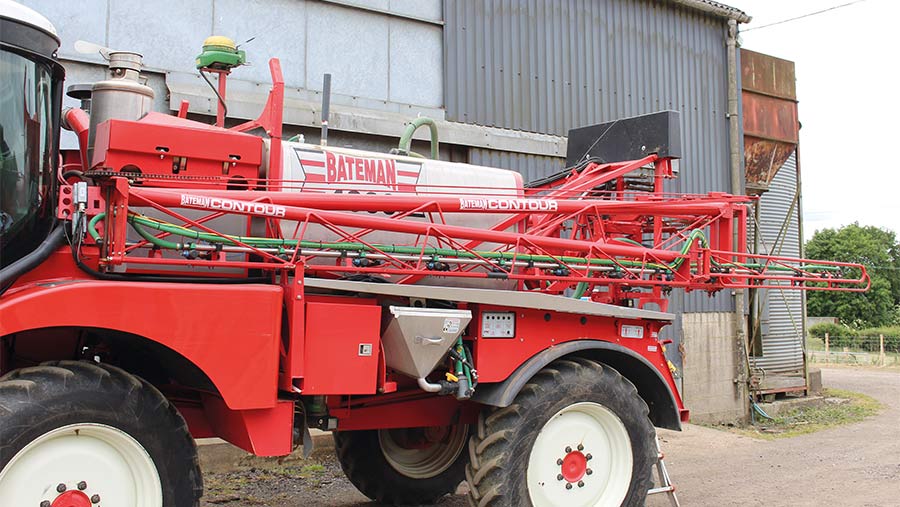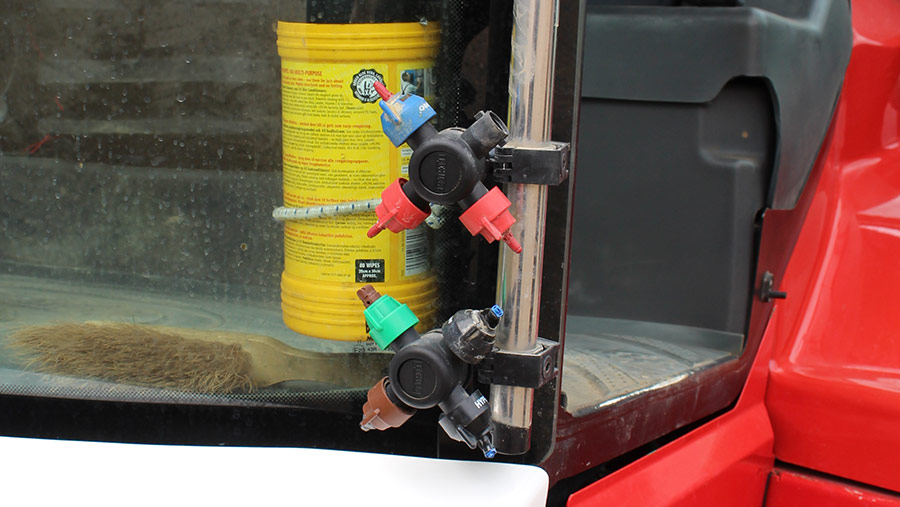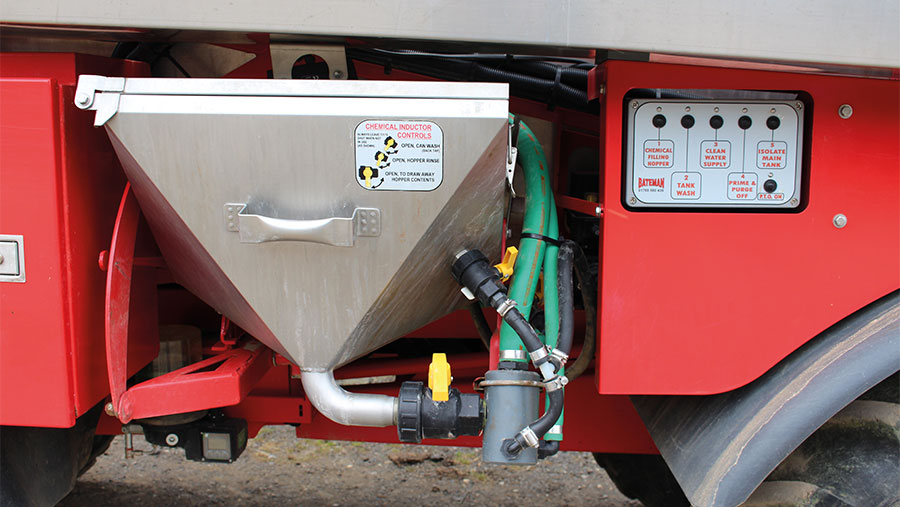Driver’s view: Luke Haynes’ Bateman RB35 sprayer

Basis-qualified Luke Haynes reveals the good and the bad of the Bateman RB35 he operates for the Montreal Estate in Kent.
See also: Broadacre spot spraying kits: All you need to know
Farm facts
- Operator Luke Haynes
- Company Montreal Estate, Sevenoaks, Kent
- Farm size 700ha (including contract work), sandy loam
- Crops grown Winter wheat, winter barley, oilseed rape, oats
- Sprayer used Bateman RB35
What sprayer are you using?
I drive a 24m Bateman RB35 with a 4,000-litre tank, which recently ticked past the 1,500-hour mark.
It replaced a second-hand Househam AR that was sold just before I arrived, as it was starting to suffer from reliability problems and was struggling to handle the workload.
Prior to the Househam, the farm employed a spraying contractor, but the manager eventually decided to bring the job back in-house.
What extras did you get?
Batemans are proper nuts and bolts machines that are simple to maintain, and mine doesn’t have many fancy extras on it.
It’s got the simpler Contour booms rather than the VG option but, in hindsight, the accuracy you get from having individual control of each side would have made a big difference on some of our sloping ground.

Bateman RB35
- List price £159,000
- Year 2017
- Hours 1,500 hours
- Engine John Deere six-cylinder
- Power 250hp
- Transmission Two-speed hydrostatic
- Road speed 40kph
- Tank size 4,000 litres
- Rinse tank size 250 litres
- Pump 400 litres/min
- Nozzles Duo React
- Auto shut-off 12-section
- Boom levelling No
- Guidance John Deere Greenstar RTK
- Boom width 24m
- Wheel sizes Michelin Xeobib 600/60 R30 flotations and Michelin Yieldbib 380/90 R50 row crops
- Average daily output 120ha
Though the Contour system is fine, only having up/down and tilt adjustment does limit things.
However, the drip trays under the booms are a nice standard fitment and help to keep the paintwork tidy.
We have John Deere’s Greenstar RTK system fitted – something we already ran on pretty much every other machine on the farm.
I have a separate Greenstar monitor for the guidance and JD’s electronic steering wheel is mounted in place of the standard Bateman unit.
All the spraying stuff, including the auto on/off, is still handled by the Ag Leader display.
I now put all the tramlines in with the sprayer and try to keep them in the same place every year.
This way, I set up the field to suit the best route around telegraph poles and trees. The lines can then be transferred to the tractor for fertiliser spreading.
One expensive addition I would like is pulse-width modulation (PWM).
The UK has been pretty slow to adopt the system, but several operators are now using it, including previous FSOOTY winner Stuart Woods, who is also based in Kent. He has done lots of research into the advantages and disadvantages and is a big advocate of it.
In fact, I think PWM could become a common item on sprayers over the next few years.
Though it’s expensive, the initial outlay will probably be offset by the chemical savings and increased yields achieved by applying products accurately.
I’ll certainly push for it when our sprayer is replaced, as I can already see blackgrass creeping in on corners and headlands as a result of underdosing.
How has it performed?
It’s been a good machine so far and the cab is a major improvement over the old Batemans.
There is loads of glass to allow for a good look at the crop and the abundance of space makes it a comfortable place to sit.
However, we recently had an AdBlue fault that required a fair bit of investigating.
As it’s a John Deere engine, we get in touch with our local Deere dealer to sort any issues – in that instance, it turned out to be a break in the wiring unit from the AdBlue pump to the engine.
Other than that, we’ve avoided any major breakdowns. I service the machine most of the time, but get the Bateman guys in once a year to check for any common issues.
I’ve now got it pretty well set up to suit my system.
Spare nozzles and bodies are held on the door handles for easy access, rather than rooting around in bags to find them – a tip I picked up from another sprayer operator in the FSOOTY competition a few years ago.

I’m also going to build a box next to the pump to house spares and tools.
At the moment, I have to bungy strap toolboxes on, which looks a little untidy and it would be safer to have them locked away.

As for output, I can usually do 120ha a day, but I’m often hampered by sub-2ha fields.
We have a big shoot on the estate and there are game covers that are bigger than the arable fields.
What are your go-to nozzles?
- Single-line system with Duo React dual-outlet bodies
- Herbicides: Defy 3D 03 and 05
- Fungicides: Guardian Air 035
- Higher water rates for course droplets: TeeJet TTI 05
What’s your spray store and fill-up area like?
The estate is in the process of finishing off a new yard for the agricultural business.
It will include a bunded filling area with a bio-filter and spray store attached to comply with legislation.
I currently use a 10,000-litre tank and a separate IBC with a submersible pump for the clean water.
This way, there is no contamination caused by the rinse tank water going through the pump that has just sucked in chemical.
My existing store is a well-organised, bunded lorry container with a big whiteboard detailing exact stock levels.
A picture of this is sent to the agronomist and kept in the office for fire risk purposes.
I installed the whiteboard so that even when I have relief help on the sprayer, everyone knows the stock and what is available.
I use cut-down water butts under the induction hopper to catch any spillages when I’m filling as I’m very conscious of contamination.

I’m hoping to trial a closed transfer system from Syngenta this year, too.
This works by locking the can in place before a probe pushes through the opening, releasing the liquid and blowing air into the can at the same time, so the chemical flies out in seconds.
It washes it as well, so the can goes straight in the recycling.
It is definitely the future of filling, as operator exposure and risk of spillages are virtually eliminated.
The farm records everything via Gatekeeper and I have a tablet in the sprayer cab to send all recommendations wirelessly.
I usually handle most of the Gatekeeper stuff in the office myself to keep things simple.
Like and gripes
Likes
- Simple to use and maintain
- Cab is a big improvement
Gripes
- Contour booms lack precision on uneven ground
- Lack of storage for spare parts
